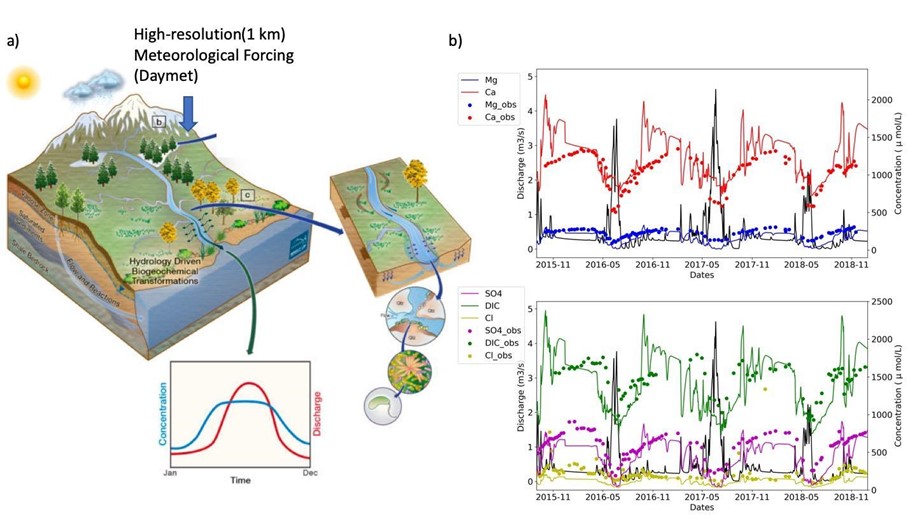August 08, 2022
Understanding the Hydrogeochemical Response of a Mountainous Watershed to Disturbances
Researchers use watershed reactive modeling to assess water quantity and quality changes in a mountainous watershed.

Response of mountainous watersheds to rain/snow dynamics under a changing climate involves processes occurring across scales/subsystems (a). Comparison between observed and simulated Concentration-Discharge responses at the watershed outlet (b).
[Reprinted under a Creative Commons Attribution-NonCommercial-NoDerivatives 4.0 International License (CC BY-NC-ND 4.0) from (a) Hubbard, S. S., et al. "The East River, Colorado, Watershed: A Mountainous Community Testbed for Improving Predictive Understanding of Multiscale Hydrological–Biogeochemical Dynamics." Vadose Zone Journal 17 (1), 1–25 (2022). DOI:10.2136/vzj2018.03.0061. (b) Xu, Z., et al. "Understanding the Hydrogeochemical Response of a Mountainous Watershed Using Integrated Surface-Subsurface Flow and Reactive Transport Modeling." Water Resources Research 58 (8), (2022). DOI:10.1029/2022WR032075.]
The Science
Climate change significantly impacts freshwater quantity and quality–especially in mountainous watersheds like the Upper Colorado River Basin that are key for water supply in downstream regions of the western United States. Researchers used a mathematical model to quantify the movement of water and chemicals under changing weather and climate conditions. This first-of-its-kind numerical model simulates hydrology and chemical transport processes at high resolution in a mountainous watershed.
The Impact
The Colorado River provides water for more than 40 million people, highlighting the urgent need to study and understand how climate change may impact the watershed’s water quality and quantity. This study’s results show that changing rainfall and early snowmelt in the Upper Colorado River Basin affect both water volume and mineral reactions, impacting water quality observed downstream. The 3D model makes it possible to understand how the watershed’s topography, stream water flow, and groundwater interact in time and space. The model demonstrates that north- and south-facing slopes of the river valley contribute differently to observed effluent concentrations. The effects are relatively small in this study but could become enhanced with larger climate variability.
Summary
The researchers studied how changing environmental factors that determine surface and subsurface water flow affect chemical transport in a watershed ecosystem. The team analyzed the relationship between the water flow volume and concentration of chemicals, or Concentration-Discharge relationship, to develop a predictive understanding of exports from the watershed to the larger river basin. The developed model simulates integrated hydrological transport and reaction processes in both surface and subsurface water. Simulation results also show that the model can resolve changes in snowmelt and infiltration associated with spatial variability throughout the watershed. Additionally, the model captures annual changes in the Concentration-Discharge relationship between wet and dry years and demonstrates how changing infiltration in time and space affects mineral weathering, which contributes to the observed effluent concentrations. Overall, this newly developed model can account for spatial variability that impacts water availability and increase understanding of how the volume of flowing water and concentration of chemicals impact water quality and quantity.
Principal Investigator
Zexuan Xu
Lawrence Berkeley National Laboratory
zexuanxu@lbl.gov
Co-Principal Investigator
Eoin Brodie
Lawrence Berkeley National Laboratory
elbrodie@lbl.gov
Program Manager
Jennifer Arrigo
U.S. Department of Energy, Biological and Environmental Research (SC-33)
Environmental System Science
jennifer.arrigo@science.doe.gov
Funding
This work is supported by the Watershed Function Science Focus Area and IDEAS-Watersheds projects, which are funded by the Biological and Environmental Research (BER) Program within the U.S. Department of Energy’s (DOE) Office of Science. This work used resources of DOE’s National Energy Research Scientific Computing Center (NERSC).
References
Xu, Z., et al. "Understanding the Hydrogeochemical Response of a Mountainous Watershed Using Integrated Surface-Subsurface Flow and Reactive Transport Modeling." Water Resources Research 58 (8), (2022). https://doi.org/10.1029/2022WR032075.

